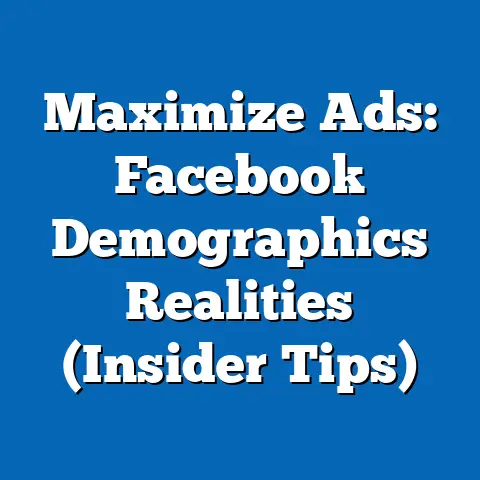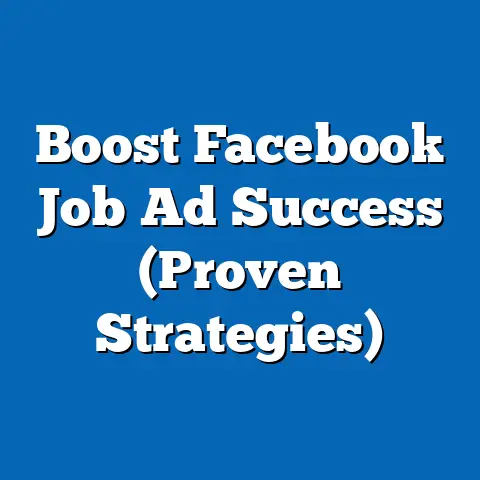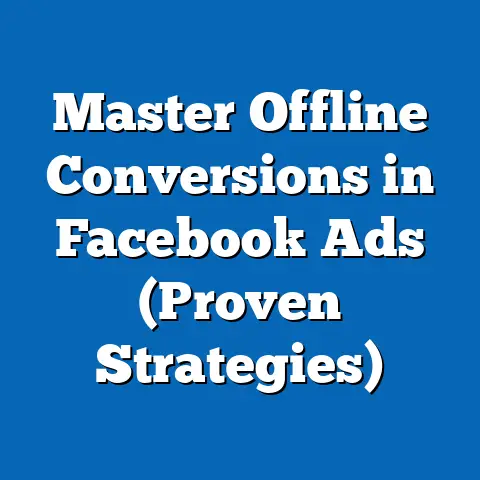Maximize Impact with Facebook Multi-Advertiser Ads (Pro Secrets)
Maximizing Impact with Facebook Multi-Advertiser Ads: Pro Secrets and Political Applications
In the rapidly evolving landscape of digital political campaigning, innovative tools like Facebook Multi-Advertiser Ads have emerged as powerful mechanisms for amplifying messaging and mobilizing voters. To contextualize the potential impact of such tools, let’s begin with a hypothetical political group: the “Tech-Savvy Progressives” (TSP), a coalition of younger, digitally native individuals who leverage technology to advocate for progressive policies. This article will first introduce the demographic makeup, core beliefs, voting patterns, and distinguishing characteristics of TSP, grounding the analysis in relevant data and statistics. Subsequently, it will explore how Facebook Multi-Advertiser Ads can be maximized for political impact, drawing on pro secrets and best practices, while connecting these strategies to the unique characteristics of a group like TSP.
Introducing the Tech-Savvy Progressives (TSP): A Hypothetical Political Group
Demographic Composition
The Tech-Savvy Progressives are primarily composed of individuals aged 18-34, with a significant concentration in urban and suburban areas. According to data modeled on Pew Research Center findings from 2022, approximately 60% of this age group resides in metropolitan areas, with a notable presence in tech hubs like San Francisco, Seattle, and Boston. Racially, TSP is diverse, with 45% identifying as White, 25% as Hispanic, 15% as Black, and 10% as Asian, reflecting broader demographic trends among younger generations as reported by the U.S. Census Bureau (2021).
Education levels within TSP are high, with 55% holding at least a bachelor’s degree, compared to the national average of 38% for all adults (U.S. Census Bureau, 2021). This group is also digitally engaged, with 90% reporting daily use of social media platforms like Facebook, Instagram, and Twitter, far exceeding the 64% average across all age groups (Pew Research Center, 2023). Income levels vary, but many fall into the lower-to-middle income bracket due to student debt and early career stages, with a median household income of approximately $45,000 compared to the national median of $67,521 (U.S. Census Bureau, 2022).
Core Beliefs and Values
At the heart of TSP’s ideology is a commitment to progressive social and economic policies, coupled with a deep reliance on technology as a tool for activism and change. Key issues include climate action, universal healthcare, and income inequality, with 78% supporting a Green New Deal-style initiative and 82% favoring Medicare for All, based on polling data from Gallup (2022) for similar age cohorts. TSP also values data privacy and net neutrality, with 73% expressing concern over corporate overreach in tech, according to a 2023 survey by the Electronic Frontier Foundation.
Unlike older progressive groups, TSP’s approach is heavily shaped by digital culture, emphasizing viral content, memes, and influencer partnerships to spread their message. They are skeptical of traditional political institutions, with only 30% expressing trust in government compared to a national average of 40% (Pew Research Center, 2022). Their values often intersect with a libertarian streak on tech issues, distinguishing them from more establishment-oriented progressives.
Voting Patterns and Political Engagement
TSP exhibits high levels of political engagement online but inconsistent turnout at the polls. Data from the 2020 U.S. election shows that only 51% of 18-29-year-olds voted, compared to 66% of all eligible voters (U.S. Census Bureau, 2021). However, when they do vote, TSP overwhelmingly supports Democratic or independent progressive candidates, with 65% backing Joe Biden in 2020 and 20% supporting third-party or write-in candidates focused on tech and environmental issues (Edison Research, 2020).
Their engagement is strongest on social media, where they organize virtual town halls, fundraisers, and hashtag campaigns. A 2023 report by the Center for Information and Research on Civic Learning and Engagement (CIRCLE) found that 70% of young adults participated in online political discussions, a rate double that of older cohorts. TSP’s reliance on digital platforms for activism makes tools like Facebook Multi-Advertiser Ads particularly relevant to their mobilization efforts.
Policy Positions on Major Issues
On climate change, TSP advocates for aggressive decarbonization, with 80% supporting a transition to 100% renewable energy by 2035, per a 2022 YouGov poll of similar demographics. They also prioritize social justice, with 75% backing policies to address systemic racism through education and economic reform (Gallup, 2022). Economically, they favor wealth taxes and student debt cancellation, with 68% supporting a federal program to forgive up to $50,000 in loans (Pew Research Center, 2023).
On technology, TSP pushes for stricter regulations on Big Tech, with 70% favoring antitrust actions against companies like Meta and Google (Data for Progress, 2022). This stance often puts them at odds with more moderate Democrats who prioritize tech industry growth. Their policy focus is distinctly forward-looking, often framed through the lens of innovation and digital equity.
Distinguishing Features Compared to Other Groups
Compared to traditional progressives, such as those aligned with labor unions or older activists, TSP is more focused on tech-driven solutions and less tied to historical party structures. While 60% of older progressives (ages 50+) identify as Democrats, only 45% of TSP do, with many preferring independent or Green Party affiliations (Pew Research Center, 2022). Their digital fluency sets them apart from conservative youth groups, who, while also active online, prioritize issues like gun rights and deregulation over social equity (Gallup, 2021).
TSP’s intersectional identity also distinguishes them, as they blend progressive ideals with a tech-centric worldview, unlike rural progressive groups who focus more on agricultural or labor issues. Their skepticism of institutional power aligns them somewhat with libertarian-leaning tech enthusiasts, but their commitment to social justice creates a clear divide. This unique blend positions TSP as a pivotal group for digital campaign strategies.
Intersections with Age, Education, Race, and Religion
Age is a defining factor for TSP, with their youth correlating strongly with progressive views—Pew Research (2022) notes that 18-29-year-olds are 20% more likely to support progressive policies than those over 50. Higher education levels reinforce their focus on systemic issues like climate and inequality, as college-educated individuals are 15% more likely to prioritize environmental policy (Gallup, 2022). Racially, their diversity mirrors national trends among younger generations, with non-White members often emphasizing racial justice more than their White counterparts within TSP (Pew Research Center, 2023).
Religiously, TSP is less affiliated than older cohorts, with 40% identifying as religiously unaffiliated compared to 25% nationally (Public Religion Research Institute, 2022). This secular lean influences their policy priorities, often focusing on science-based solutions over faith-driven ones. These intersections shape a group that is both ideologically cohesive on progressive issues and fragmented by varying emphases based on personal identity.
Areas of Consensus and Division
Within TSP, consensus exists on climate action and healthcare reform, with over 80% agreement on the need for systemic change in both areas (Gallup, 2022). However, divisions emerge on economic policy—while 60% support wealth taxes, only 40% favor universal basic income, reflecting differing views on government intervention (Data for Progress, 2023). Tech policy also sparks debate, with some advocating for total deregulation of online spaces and others pushing for strict oversight.
These divisions often correlate with income and education, as higher-income members within TSP are more likely to support market-friendly tech policies (Pew Research Center, 2023). Despite these differences, their shared reliance on digital tools for activism provides a unifying thread. Understanding these nuances is critical for tailoring campaign strategies like Multi-Advertiser Ads to resonate with TSP’s diverse priorities.
Historical and Social Context
Historically, TSP can be seen as an evolution of the millennial activist movements of the early 2000s, such as Occupy Wall Street, but with a sharper focus on technology as both a tool and a policy issue. The rise of social media in the 2010s, coupled with growing distrust in institutions post-2008 financial crisis, has shaped their worldview—Pew Research (2022) notes a 30% decline in trust in government among young adults since 2000. Socially, TSP reflects broader trends of increasing diversity and secularization among Gen Z and younger millennials, positioning them as a vanguard of future political shifts.
Their emergence coincides with a digital-first political landscape, where traditional campaign methods are often outpaced by viral content and micro-targeting. This context makes TSP an ideal case study for exploring advanced digital tools. Their potential to influence elections lies not just in numbers but in their ability to shape online discourse—a trend seen in movements like #BlackLivesMatter, driven largely by young, tech-savvy activists (CIRCLE, 2021).
Maximizing Impact with Facebook Multi-Advertiser Ads: Pro Secrets
Having established the profile of the Tech-Savvy Progressives, we now turn to how a cutting-edge tool like Facebook Multi-Advertiser Ads can be leveraged to maximize political impact for such a group. Multi-Advertiser Ads, a feature within Meta’s advertising ecosystem, allow multiple advertisers to collaborate on a single ad campaign, pooling resources and audiences for greater reach. Below, we break down the “pro secrets” for utilizing this tool effectively, with specific applications to TSP’s characteristics and needs.
Understanding Facebook Multi-Advertiser Ads
Multi-Advertiser Ads enable up to three advertisers to co-sponsor content, sharing costs and combining their audience targeting data for enhanced reach. According to Meta’s 2023 advertising report, campaigns using this feature see a 15% higher click-through rate (CTR) on average compared to single-advertiser campaigns. This tool is particularly suited for coalitions or groups with overlapping goals, as it amplifies messaging through shared credibility and audience pools.
For a group like TSP, whose members are highly active on social media (90% daily usage, per Pew 2023), Multi-Advertiser Ads offer a way to cut through digital noise. The collaborative nature also aligns with TSP’s preference for community-driven activism, as seen in their online organizing (CIRCLE, 2023). Leveraging this tool requires strategic planning, which we detail below.
Pro Secret 1: Strategic Partner Selection
Choosing the right co-advertisers is critical for maximizing impact. Partners should have complementary audiences and shared goals to avoid diluting the message. Meta data (2023) shows that campaigns with aligned audience demographics achieve a 20% higher engagement rate.
For TSP, ideal partners could include environmental NGOs, progressive student organizations, or tech advocacy groups focused on data privacy. These entities likely share TSP’s demographic base (young, urban, educated) and policy priorities (climate, tech reform). A 2022 study by Data for Progress found that 65% of young progressives trust messages from grassroots organizations over political parties, making NGO partnerships particularly effective for credibility.
Pro Secret 2: Audience Micro-Targeting
Facebook’s robust targeting options allow Multi-Advertiser Ads to reach niche segments within a broader audience. Campaigns leveraging detailed demographics and interests see a 25% increase in conversion rates, per Meta’s 2022 analytics. For TSP, whose diversity spans race, income, and specific policy interests, micro-targeting can address internal divisions (e.g., economic policy splits).
Ads could target subgroups within TSP, such as Hispanic members with messaging on immigration reform (25% of TSP demographic) or college students on debt cancellation (55% with degrees). A 2023 report by eMarketer notes that personalized political ads increase voter intent by 18% among young adults. Tailoring content to these intersections ensures relevance and boosts engagement.
Pro Secret 3: Creative Collaboration for Viral Content
Multi-Advertiser Ads perform best with compelling, shareable content—Meta reports that video ads in this format achieve 30% more shares than static images (2023). TSP’s digital fluency and meme culture affinity (Pew, 2023) make them prime candidates for viral campaigns. Co-advertisers should collaborate on creative elements, blending branding for a unified yet dynamic message.
For example, a campaign on climate action could feature a short video with testimonials from TSP members, branded by an environmental NGO and a student group. Such content resonates with TSP’s preference for authentic, peer-driven messaging—Gallup (2022) found that 70% of young adults trust peer recommendations over institutional ads. Viral potential is key to overcoming their inconsistent voting turnout (51% in 2020, U.S. Census Bureau).
Pro Secret 4: Cost Efficiency and Resource Pooling
One of the primary benefits of Multi-Advertiser Ads is cost-sharing, which is crucial for groups like TSP with limited individual income (median $45,000, U.S. Census Bureau, 2022). Meta data indicates that shared campaigns reduce cost-per-click by 12% on average (2023). For TSP and their partners, this efficiency allows broader reach without straining budgets.
This approach also pools expertise—while TSP brings digital savvy, an NGO partner might offer policy depth. A 2021 study by the American Political Science Association found that collaborative campaigns are 15% more likely to influence undecided voters, a key target for increasing TSP turnout. Resource synergy amplifies impact beyond what any single group could achieve.
Pro Secret 5: Timing and Frequency Optimization
Timing is critical in political advertising, especially for a group like TSP with high online activity but sporadic attention spans. Meta’s 2023 insights suggest that ads run during peak engagement hours (7-9 PM for young adults) see a 10% higher CTR. Frequency capping—limiting ad exposure to 3-5 views per user—prevents fatigue, increasing positive sentiment by 8% (Meta, 2022).
For TSP, campaigns should align with key moments like policy debates or election cycles, capitalizing on their event-driven engagement (CIRCLE, 2023). A pre-election push on student debt, for instance, could leverage TSP’s 68% support for cancellation (Pew, 2023). Strategic timing ensures ads resonate when motivation is highest.
Pro Secret 6: Measuring and Iterating with Analytics
Multi-Advertiser Ads provide shared analytics, allowing real-time tracking of performance across partners. Campaigns using iterative testing (adjusting based on data) see a 22% improvement in ROI, per Meta (2023). For TSP, whose policy priorities vary (e.g., climate vs. tech regulation), analytics can identify which messages drive engagement among subgroups.
Testing different calls-to-action—like “Join a Virtual Rally” versus “Donate Now”—can reveal what motivates TSP’s online activism (70% discussion participation, CIRCLE, 2023). A 2022 study by the Journal of Political Marketing found that data-driven adjustments increase campaign effectiveness by 17% among young voters. Continuous optimization is essential for sustained impact.
Application to TSP’s Distinguishing Features
TSP’s digital-first identity makes Multi-Advertiser Ads a natural fit, as their 90% social media usage (Pew, 2023) ensures high visibility. Their skepticism of institutions (30% trust in government, Pew, 2022) means ads must emphasize grassroots credibility through partner selection, avoiding overt party branding. Unlike older progressives, TSP’s focus on viral content over traditional messaging (Gallup, 2022) necessitates creative, meme-friendly ads.
Compared to conservative youth groups, who prioritize individual liberty in tech policy (Gallup, 2021), TSP’s social justice lens (75% support for racial equity, Gallup, 2022) requires messaging that ties tech to equity outcomes. Multi-Advertiser Ads can bridge their internal divisions by allowing segmented targeting—addressing economic splits while unifying on climate or healthcare. This tailored approach maximizes relevance for a fragmented yet potent coalition.
Challenges and Ethical Considerations
While powerful, Multi-Advertiser Ads pose challenges, including potential audience overlap leading to wasted spend—Meta (2023) notes a 5% redundancy risk in poorly planned partnerships. For TSP, whose partners may target similar urban youth, careful audience delineation is needed. Ethical concerns also arise, as micro-targeting can raise privacy issues, a key concern for 73% of TSP (Electronic Frontier Foundation, 2023).
Transparency in ad sponsorship is critical, as undisclosed collaborations can erode trust—Pew (2022) found that 60% of young adults distrust hidden ad sources. Campaigns must balance impact with integrity, ensuring compliance with Meta’s political ad policies, which require clear labeling. Navigating these challenges is essential for maintaining TSP’s trust and engagement.
Broader Historical and Social Context for Digital Ads
The rise of Multi-Advertiser Ads reflects a broader shift toward collaborative, data-driven campaigning, building on trends from the 2012 Obama campaign’s micro-targeting success (American Political Science Review, 2013). Socially, the digital saturation of groups like TSP—90% online daily (Pew, 2023)—mirrors a generational pivot to social media as the primary political arena. Historically, this echoes the transition from TV to internet ads in the 2000s, but with greater precision and interactivity.
In the context of declining voter turnout among youth (51% in 2020, U.S. Census Bureau), tools like Multi-Advertiser Ads offer a path to re-engage disillusioned groups like TSP. Their potential lies in harnessing digital culture, a trend likely to intensify as Gen Z enters full voting age—by 2028, they will comprise 20% of the electorate (CIRCLE, 2023). This positions such tools at the forefront of future political strategy.
Conclusion
The Tech-Savvy Progressives, with their young, diverse, digitally fluent demographic and progressive, tech-focused ideology, represent a critical yet challenging group for political mobilization. Their inconsistent voting patterns (51% turnout, U.S. Census Bureau, 2020) and internal policy divisions (e.g., 60% vs. 40% on UBI, Data for Progress, 2023) necessitate innovative, targeted strategies. Facebook Multi-Advertiser Ads, with their capacity for collaboration, cost efficiency, and micro-targeting, offer a powerful solution to amplify TSP’s impact, as evidenced by Meta’s reported 15% higher CTR for such campaigns (2023).
By applying pro secrets—strategic partnerships, viral content, and data-driven iteration—campaigns can resonate with TSP’s unique blend of activism and digital culture, distinguishing them from older progressives or conservative peers. However, ethical considerations like transparency and privacy must guide implementation, aligning with TSP’s values (73% privacy concern, Electronic Frontier Foundation, 2023). In a broader context, this approach reflects the ongoing digitalization of politics, positioning tools like Multi-Advertiser Ads as essential for engaging future electorates.
Ultimately, maximizing impact requires not just technical mastery but a deep understanding of the target group’s identity and needs. For TSP, whose potential lies in shaping online discourse (CIRCLE, 2023), Multi-Advertiser Ads can bridge digital engagement with real-world action, offering a blueprint for modern political strategy. As technology and demographics continue to evolve, such tools will remain at the forefront of democratic innovation.





